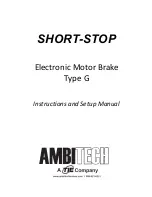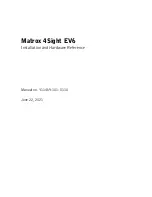
2
1.
INTRODUCTION
The SHORT-STOP electronic motor brake permits rapid
stopping of AC motors by DC injection, creating a station-
ary magnetic field within the motor.
Braking action is smooth, adjustable and frictionless.
Torque and time adjustments permit matching the braking
rate to almost any machine requirement.
The installation of standard units simply involves connec-
tion of six wires to the machine motor starter.
The SHORT-STOP has no effect on normal machine
performance, operation or motor life.
- FEATURES -
[ ] FRICTIONLESS BRAKING
[ ] TORQUE IS FULLY ADJUSTABLE
[ ] NO MECHANICAL CONNECTIONS
[ ] INTERNAL FUSES FOR PROTECTION
2.
DESCRIPTION AND APPLICATIONS
The SHORT-STOP works with all AC motors other than
universal types. Each SHORT-STOP model covers all
motor sizes up to its rating for horsepower and amps.
Standard units are completely satisfactory for most
applications, particularly woodworking and metalworking
machines such as saws, lathes, grinders, sanders, etc.
Other applications are to replace worn-out mechanical
brakes, to minimize maintenance and to provide adjustable
stopping rates. They make retrofitting older machines
easy, since no mechanical connection is required.
Electronic brakes are useful where coasting is either a
production or a safety problem. However, since electronic
brakes require power to operate and do not provide
holding, they cannot be used as "fail-safe" brakes.
3.
SAFETY NOTES
LOCK TOOL OR BLADE SECURELY
. Saws and
grinders are often fastened with left-hand thread devices,
which tend to loosen when the machine is stopped too
quickly. Use of double nuts, or other positive locking
methods to prevent such loosening. Since braking may be
set to exceed starting torque, test for safe operation during
braking and check locking from time to time.
DON'T TAMPER WITH WIRING OR MAGNETIC
CONTACTOR
. Once installed and adjusted, the SHORT-
STOP box cover should be closed securely.
Tampering with the internal parts or manually operating
the magnetic contactor is not only dangerous, but can
cause damage not covered by the warranty.
POWER LINE INTERRUPTION
. The SHORT-STOP
uses AC line power to achieve its braking action. Thus a
power failure or disconnect, or the opening of a fuse, will
simply let the motor coast to a stop without braking. Do
not use the SHORT-STOP where failure to provide
braking will be a hazard.
HOLDING AGAINST A LOAD
. The SHORT-STOP
cannot be used as a positive brake against overhauling
loads after the motor stops. In such applications, a
positive lock, a pin, or a separate mechanical brake must
be used to provide for holding at rest. Call factory for
information on other models if holding is desired.
4.
LIMITATIONS
MOTOR TYPES. The SHORT-STOP will work with all
induction motors, including wound rotor types, and with
all three phase motors. It will work with all single-phase
motors except for DC and universal motors.
MOTOR HEATING. The heat generated during braking
can be considered equivalent to adding another start cycle,
if the TORQUE control is set very high. Therefore, high
cycle operations may require fan cooling.
Although motor heating is rarely a problem, it is
minimized by using the lowest torque setting that gives
acceptable operation.
IT IS UP TO THE USER TO INSURE THAT HIS
MOTOR WILL BE PROTECTED FROM EXCESSIVE
HEAT RISE, WHETHER FROM EXTREMES OF
RUNNING, STARTING OR BRAKING.
POWER OR FUSE FAILURE. Loss of power means loss
of braking, regardless of whether power is disconnected by
a switch, line or internal fuse, circuit breaker, etc. This also
applies to fuses internal to the SHORT-STOP, where the
fuses are intended for the protection of internal
components.
POWER FACTOR CAPACITORS. Power factor capaci-
tors may NOT be used across a LOAD controlled by the
SHORT-STOP. Move any such capacitors to the LINE
side of the starting contactor per NEC Procedures.
DON'T OPEN POWER TO TERMINALS 1 AND 2. If
power is simply removed from the power input terminals
of the SHORT-STOP during braking, the power contactor
will open under load and may damage the SHORT-STOP,
and will not stop the motor.
5.
RATINGS
All SHORT-STOP units may usually be used up to the
published ratings of horsepower or current - whichever is



























